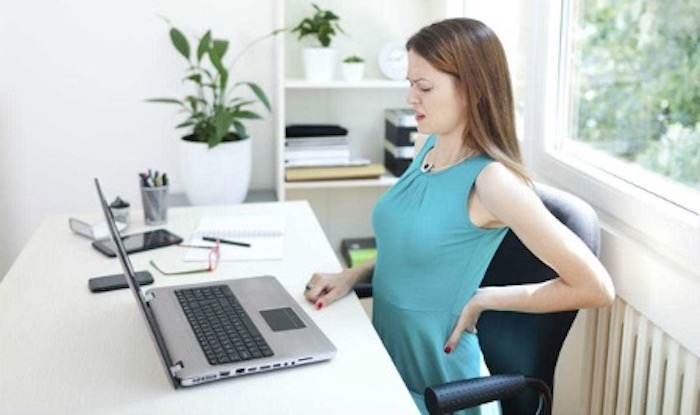
If you have tried different types of office chairs and your back pain still persists, you may need to move on from the conventional seated-chair design to an alternate method.
Here are 5 options to consider try a few out, to see which ones work best.
1. Standing Desk
A raised desk allows you to work while standing. Standing engages your core muscles more than sitting, and it can lead to better posture and spinal alignment. Switching between sitting and standing can also help manage chronic back pain.
If you choose to use a standing desk, follow these tips:
- Make sure that your standing desk is raised to a height from which you can work comfortably.
- Your arms should be able to bend at a 90-degree angle while you use your computer, and you should be able to look straight ahead at your monitor without tilting your neck down.
- Place a thick (or memory foam) mat underneath you to keep things gentle for your feet and knees.
- Consider using a pedestal or footstool, so you can occasionally shift your weight.
To help you switch between sitting and standing, use a standing desk converter. It sits on top of your current desk and can be raised to the height of a standing desk. Alternate between sitting and standing as you feel comfortable.
2. Recliner Office Chair with A Laptop Stand
If you feel comfortable working in a reclined position rather than sitting upright, try a reclining office chair. A recliner chair has a headrest, footrest, and an ergonomically positioned laptop stand for you to work comfortably.
Advantages of a recliner chair are:
- It may keep you from slumping forward and putting pressure on your lower back.
- You don’t have to slope your neck downward or strain your arms to work on the computer.
Different levels of reclination may work for different people, so you may need to try a few angles. Place a small rolled towel in the small of your lower back for additional support.
3. Exercise Ball
Sitting on an exercise ball is an active process that requires you to constantly balance your body. When you sit on an exercise ball:
- Your body continually makes minor adjustments to stay balanced, which engages the muscles in your core and lower back.
- It encourages good posture due to the absence of a backrest.
- If you like to fidget or move around a little, the exercise ball lets you bounce up and down.
Be sure to check the size of your exercise ball, as they are available in various sizes. Ideally, when you sit on the ball, your hips should be at the same level as your knees (or about an inch higher than your knees). This way, your thighs are level, or slightly sloping down to your knees.
You may want to get an exercise ball with a base at the bottom, or an exercise ball chair, to prevent the ball from rolling away when you stand up.
4. Ergonomic Stool
An ergonomic stool, sometimes marketed as a balance stool or active stool, is a dynamic seating option similar to an exercise ball.
When you use this stool:
- The high seat encourages you to half-stand with your feet on the floor, taking the pressure off your lower back.
- The pivoting base and lack of backrest require you to engage your core and practice good posture.
Some people prefer an ergonomic stool over an exercise ball because it stands out less in a professional environment while providing many of the same benefits.
5. Kneeling Chair
A kneeling chair provides a padded seat for you to sit and is angled forward to shift some of your body weight to your shins and knees.
While sitting on a kneeling chair:
- Your spine is in a more neutral position, taking the pressure off your lower back.
- The lack of a backrest encourages good posture and may prevent slumping.
Sitting in the kneeling position for long periods of time may be difficult at first, so switch to another chair or seating option at frequent intervals. Even if you get adjusted and comfortable on a kneeling chair, alternating with another chair is advised to avoid prolonged kneeling. Also, be sure to get an adjustable kneeling chair so you can find the position that works best for you.
This list is by no means exhaustive, so feel free to try out different options and choose the one that feels best for you. Keep in mind that no matter which office chair alternative you choose, one of the best ways to keep your back healthy is to take breaks several times a day. Every 50 minutes to an hour plan to go for a short walk and stretch your back, neck, and hamstring muscles to improve the strength, stability, and flexibility of your spine.
Precision Pain Care and Rehabilitation has two convenient locations in Richmond Hill – Queens and New Hyde Park – Long Island. Call the Richmond Hill office at (718) 215-1888, or (516) 419-4480 for the Long Island office, to arrange an appointment with our Interventional Pain Management Specialist, Dr. Jeffrey Chacko.













